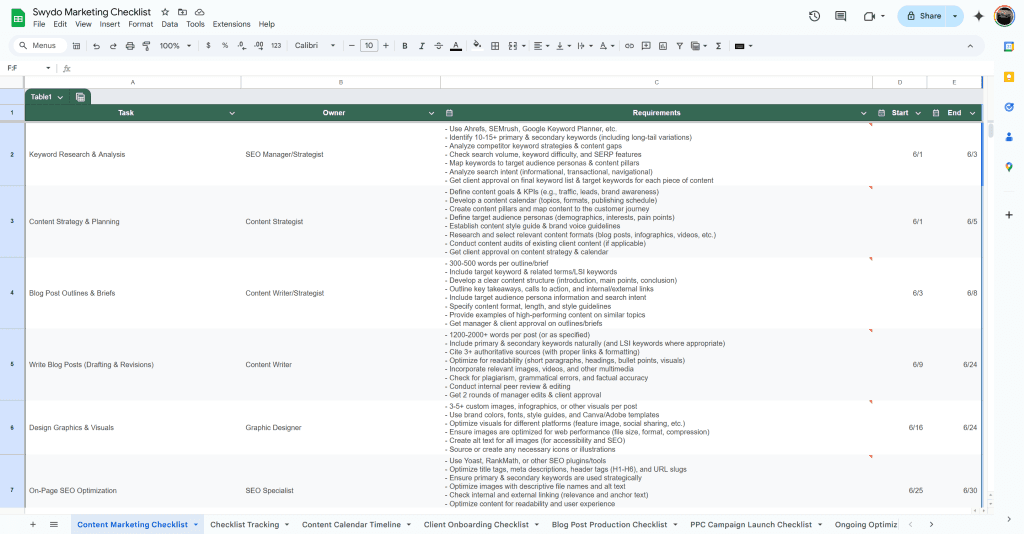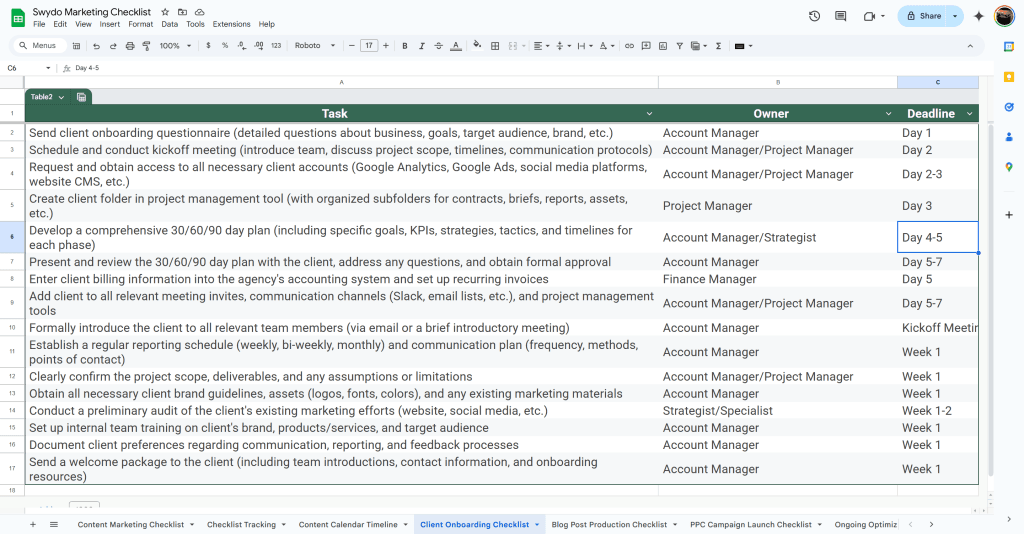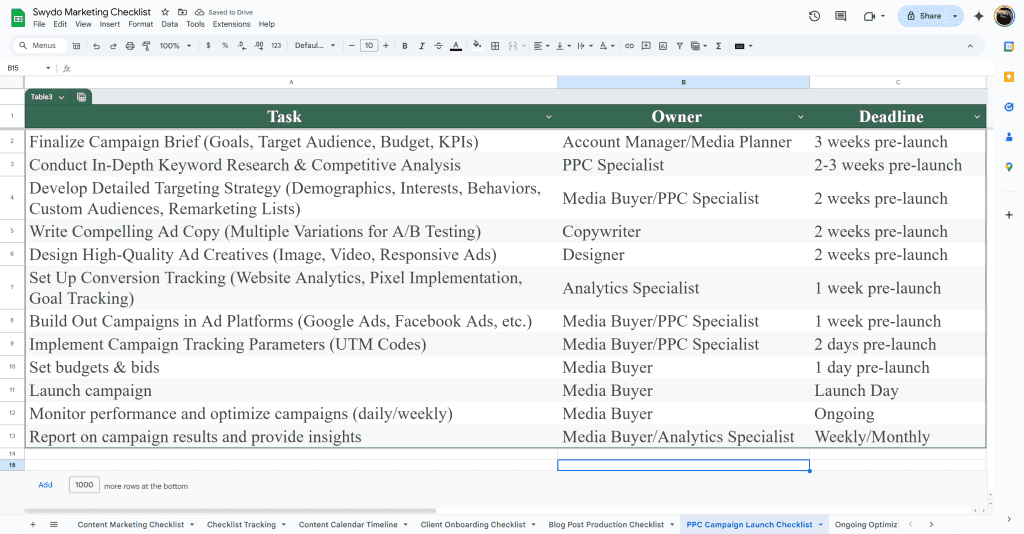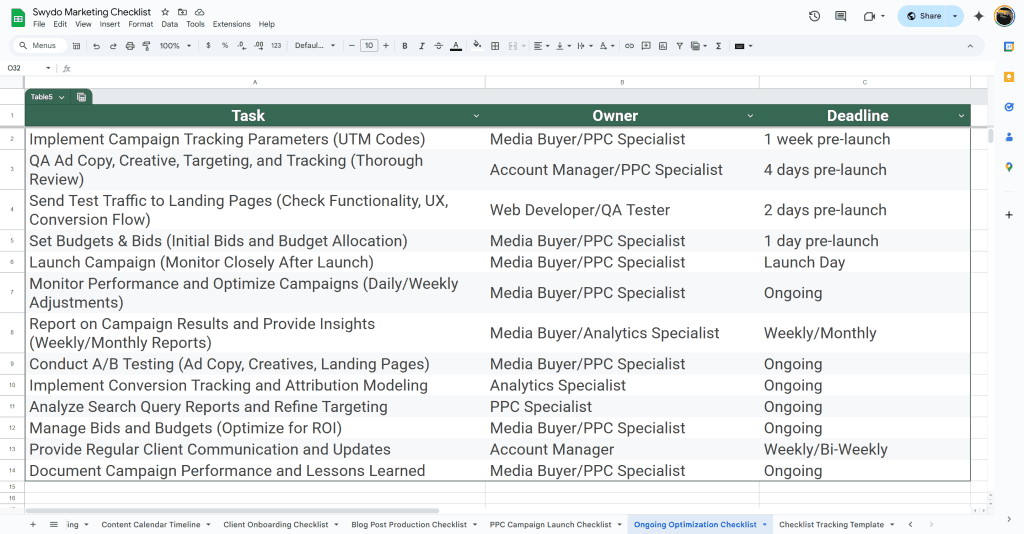Running an agency is like being the ultimate juggler. Between managing team meetings, chasing client deadlines, and delivering creative work, there’s always another ball in the air.
If you’re nodding your head right now, you know exactly what I mean—you’re the one making sure everything gets done on time, meets those high standards, and keeps your clients coming back for more.
But there’s a better way to handle all those moving pieces. A solid marketing checklist, built around how your agency actually works, can be a game-changer. Think of it as your go-to playbook that keeps everyone on the same page, catches those sneaky mistakes before they happen, and stops your team from playing the “what’s next?” guessing game.
Consider the insight of Atul Gawande in The Checklist Manifesto: How to Get Things Right (affiliate link😊), where he states,
Under conditions of complexity, not only are checklists a help, they are required for success. And the reason is increasingly evident: the volume and complexity of what we know has exceeded our individual ability to deliver its benefits correctly, safely, or reliably.
Just as a surgical team depends on a well-designed checklist to avoid critical errors, your agency can use one to manage a flood of tasks and shifting priorities. This isn’t about stifling creativity—it simply frees up your team’s mental space so they can focus on strategic work instead of worrying about overlooked details.
Let’s explore how to build checklists that make your day easier instead of adding more paperwork.
Why Checklists Make Sense in a Growing Agency
As your agency grows, clarity, consistency, and efficiency become even more important. A well-prepared checklist not only confirms every essential step but also offers a clear framework for success. Consider these benefits:
| Benefit | Description |
|---|---|
| Smooth Campaign Execution | A step-by-step guide that helps your team move confidently from planning to post-campaign analysis. |
| Clear Task Delegation | Everyone knows their part, so confusion and overlap take a back seat. |
| Streamlined Operations | A unified process saves time and reduces errors. |
| Data-Driven Decisions | With key metrics in place, adjustments rely on solid data rather than guesswork. |
| Enhanced Client Onboarding & Content Quality | A consistent process builds trust from the very start. |
| Goal Clarity | Each campaign sets measurable objectives that everyone understands from the beginning. |
A well-designed checklist is more than a list of tasks—it brings order to the chaos, making sure nothing important falls through the cracks.
How Checklists Can Overcome Roadblocks
Every growing agency faces its share of challenges. When processes aren’t clearly laid out, tasks can be missed, roles become unclear, and quality may suffer. A detailed checklist can help prevent these issues:
| Obstacle | The Challenge | How a Checklist Helps |
|---|---|---|
| Missed Steps | Busy schedules lead to skipped critical actions. | A checklist ensures every key task appears and gets done. |
| Unclear Responsibilities | Ambiguity causes overlapping efforts and miscommunication. | Designated task owners remove the guesswork and keep work flowing. |
| Variable Output | Without standard processes, quality can vary. | A consistent checklist guarantees uniformity in every project. |
| Rework and Revisions | Vague instructions lead to repeated work. | Clear guidelines minimize the need for constant revisions. |
| Lack of Data Integration | Decisions based solely on instinct can miss important cues. | Embedding key performance metrics guides objective decision-making. |
| Missed Audience Focus | Campaigns suffer if they don’t speak to the right people. | Including research details keeps the focus sharp and effective. |
The Five-Part Process for Building Your Marketing Checklist
The beauty of a checklist lies in its ability to capture each phase of your operation. It’s not effective if it’s just a random list of tasks. Use this five-step structure to create a detailed yet streamlined checklist that tackles real-world challenges.
1. Brainstorm Every Actionable Step
Gather your team—at least the key players—and write down every action you typically perform for a particular process. Think about an inbound content campaign that might include everything from initial keyword research to final blog publication. Don’t overthink it here; just list tasks, whether they’re big milestones or small steps.
Bu before listing tasks, define the overarching goals for this process using a goal-setting framework. This will help every task on your checklist contributes to achieving those goals.
2. Trim and Prioritize
Once you have the full range of tasks, filter them by asking if each one is essential for success. Will skipping a specific action hurt your final outcome? This approach helps you remove steps that might be optional or rarely needed.
3. Clearly Assign Ownership and Criteria
A solid checklist includes a designated owner for each action, along with the exact standard for completion. If it’s writing a blog post, maybe “done” means a draft of 1,500 words with certain keywords used a set number of times. Pinpoint those criteria to avoid confusion.
4. Build Your Timeline in Reverse
Figure out your final deadline, then decide when each task must wrap up. If the blog post needs to go live on the first of the month, editing may need to finish a week prior, and the first draft might be due the week before that. Work backward to ensure no one is caught off guard.
5. Test It, Refine It, and Iterate
Treat your initial checklist as a starting point. Try it on a real project or two, then ask your team what worked and what didn’t. Use that information to adjust your list. As your agency grows or shifts focus, you can revisit and update the checklist to stay relevant.
Bonus Steps
Some agencies create a solid checklist yet fail to gain maximum benefits. Strengthen each step by following these pointers:
- Define Goals Upfront: Before creating the checklist, clearly outline the goals for the project or campaign using a goal-setting framework like SMART goals. This aligns every checklist item with achieving those objectives.
- Involve Multiple Perspectives: Invite input from everyone who touches the project. A writer might see potential roadblocks an account manager overlooks. A designer might suggest additional tasks that ensure brand alignment. Casting a wide net for feedback leads to a more complete list of action items.
- Document “Why” for Each Action: Teams often skip or rush steps if they don’t understand why those steps matter. Add short notes about the purpose behind each major action, especially if it directly impacts the final quality or the client’s satisfaction.
- Preempt Common Bottlenecks: Look back on previous projects to see where tasks stalled. Did client approvals take forever? Did design requests arrive too late? Factor these slow points into your timeline so you have buffer time built in.
- Create a One-Page Summary: Put the most critical steps in a short, high-level reference. That allows team members to quickly see the project’s arc at a glance. They can then refer to the more detailed checklist when they need deeper instructions.
- Establish Check-In Moments: Insert mini “milestones” in the middle of your checklist. After you complete a set of tasks, pause to confirm you’re still in line with the project goal or the client’s evolving needs. This approach helps your team pivot if something changes.
Example Content Marketing Checklist
Below is a simplified table to illustrate how you might set up your content marketing checklist. The left column identifies the task, the middle column names the owner, and the right column points to some notes or key details.

This table keeps each step scannable and straightforward for the entire team.
What Tools Can I Use to Create and Manage My Checklists?
Many agencies discover that a straightforward platform like Google Sheets fits their style, offering real-time collaboration without complex features. Others rely on advanced project management solutions such as Asana, Trello, Airtable, ClickUp, or Pipefy.
The ideal choice depends on factors like user-friendliness for your team and whether it updates tasks in real time. Some platforms—including Google Sheets—support template duplication or file attachments, while others integrate with Slack or email for smoother communication.
- Asana provides task management, timeline views, and template creation.
- Trello features a visual kanban-style board, perfect for teams that thrive on visual cues.
- Airtable offers a blend of spreadsheet functionality with a database approach for customized data handling.
- ClickUp supports multiple views to suit various work styles.
- Pipefy focuses on automated workflows and built-in forms for capturing project data.
Use these platforms to explore a few advanced tactics. Some campaigns might skip certain tasks based on budget or goals, so consider adding conditional logic that outlines “if X, then do Y.” Many modern apps offer automation, so marking “Blog Post Draft Finished” can alert an editor that it’s time to review. Several of these solutions also provide reporting or dashboard features to spot overdue tasks and optimize your workflow even further.

This onboarding checklist makes a solid first impression by being structured. It lays out each step so no one is confused about who does what and by when.
How to Apply Checklists to Different Services
Building a single checklist for everything might seem convenient, but each service your agency offers will likely require different deliverables, deadlines, and approval steps. A specialized checklist helps everyone stick to the right sequence for tasks that vary from client to client.
The table below illustrates how you could break down some of the most common service areas, showing typical tasks alongside key considerations that keep each project on track.
| Service | Key Steps | Additional Considerations |
|---|---|---|
| Paid Advertising | Budget approvals, ad copy creation, landing page reviews, final QA. | Monitor metrics and make sure its consistent branding and tracking. |
| SEO Campaigns | Technical audits, on-page optimization, content development, reporting. | Set baseline rankings and fine-tune keyword strategies. |
| Social Media Management | Daily content scheduling, weekly reviews, monthly strategy sessions, influencer outreach. | Keep track of engagement and adjust guidelines as needed. |
| Public Relations | Media list updates, pitch drafting, distribution, event coordination. | Maintain clear messages and strong media relationships. |
This structure provides your team with a detailed view of tasks, timelines, and the unique requirements for each service area.
This PPC campaign launch checklist example below demonstrates how tasks, timelines, and owners can appear in one table so no one wonders what comes next:


Use these additional marketing checklists as templates or inspiration for refining your own workflows. Each one addresses a different marketing scenario, offering a starting point you can adapt to fit your agency’s style. You can make a copy of our template here.
Also, check out some of our other articles:
How to Track the Impact of Your Checklists
It’s helpful to measure how your updated approach affects daily operations. A few metrics to track include:
- Time to Completion: Compare how long it took to finish a typical project before and after using the checklist.
- Error or Rework Rate: Count how often tasks need redoing. A well-structured checklist cuts down on these issues.
- Client Satisfaction: Gather feedback through surveys or direct conversations. Positive changes often correlate with fewer hiccups.
- Team Stress Levels: This can be subjective, but a reduction in frantic messages or late nights indicates your system works.

If these numbers improve, your checklist likely plays a positive role. If not, it may be time to reevaluate how the checklist is built or implemented.
In addition to tracking time to completion, consider these key performance indicators:
- Website Traffic: Monitor SEO metrics such as unique visitors, page views, and bounce rates to assess the impact of your content and SEO efforts.
- Lead Generation: Track the number of qualified leads, cost-per-lead, and conversion rates to evaluate campaign effectiveness.
- Email Marketing Performance: Evaluate open rates, click-through rates, and unsubscribe rates to gauge the success of your email campaigns.
- Social Media Engagement: Assess follower growth, likes, shares, and comments to determine how well your social media strategy is resonating.
Ultimately, consistent performance tracking is key to understanding a checklist’s impact. This data-driven approach validates the checklist’s value and pinpoints areas for refinement, helping clients’ businesses thrive. A checklist’s success hinges on measurable results.
How to Integrate Your Marketing Checklists into Your Culture
For a checklist to really work, it needs to be part of everyday practice. Here are some steps to help with that:
| Step | Implementation Tip | Benefit |
|---|---|---|
| Promote Transparency | Explain how a checklist clarifies roles and expectations. | Reduces confusion and streamlines workflow. |
| Conduct Short Training Sessions | Walk your team through the checklist’s structure. | Increases comfort and minimizes misunderstandings. |
| Gather Ongoing Feedback | Encourage everyone to suggest changes when needed. | Make sure the process evolves with your agency. |
| Recognize Successes | Share examples where the checklist prevented problems. | Boosts morale and reinforces the checklist’s value. |
| Update When Needed | Review the checklist as projects or tools change. | Keeps your process current and effective. |
| Monitor Progress Proactively | Check for stalled tasks or missed steps and address them. | Helps catch bottlenecks early and maintain smooth operations. |
Placing this table (or a similar version) in a shared location—such as a company wiki or project management tool—keeps the integration process visible to everyone. Encourage your team to check off each row periodically, and consider how these steps might need to adjust as your agency gains new clients, launches new services, or transitions to new tools. Making checklist adoption part of everyday routines leads to fewer errors, faster turnaround times, and a significant boost in team confidence.
Conclusion
Most agencies juggle numerous moving parts—from client intake to final campaign delivery. Relying solely on memory or ad hoc notes often leads to inconsistencies, missed deadlines, and unnecessary stress. A tailored marketing checklist provides a reliable framework that keeps everyone aligned and ensures your projects run smoothly.
The best checklists are dynamic; they evolve as you gather feedback, incorporate new tools, and adapt to shifting market conditions. Over time, these documents become a core component of your agency’s success strategy—helping you scale your business with fewer errors, clearer collaboration, and measurable improvements in performance.
If you haven’t tried using a checklist yet, consider giving it a go on your next project. Test it, get feedback, and adjust along the way. Over time, you’ll notice smoother operations, fewer errors, and a more confident, coordinated team.
